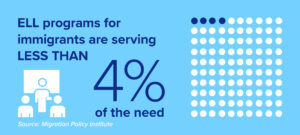By 2030, 97% of net workforce growth in the U.S. will be immigrants and their children. That, from a recent white paper – Situation Analysis: Immigration and the Future of the Workforce – from EnGen.
Katie Brown, Ph.D., the organization’s founder and chief education officer, explains the B Corp’s “mission is to remove English as a barrier for immigrants, refugees, and speakers of other languages so that they can get access to jobs and the potential for economic mobility.”

Brown notes the entire approach to language instruction needs a reset, “As a country, we still don’t think about language the right way. It’s why middle school students across the United States are sitting in Spanish classes and they are learning to conjugate boot verbs. They are not learning how to do anything useful which means we have a culture of thinking about language as an insurmountable obstacle.”
Traditional paths to English-language learning are not having a far enough reach. The report states, “ELL programs for immigrants – largely run through local nonprofits, community colleges, and school districts – are serving less than 4% of the need.” That comes from a 2018 Migration Policy Institute report.
The Return on Investment
Brown emphasizes that English language skills will allow people to get into career training programs that will lead to family-sustaining wages. And employers can be part of that solution. Brown says, “The onus is on the employers. If these people could get access to instruction through the workplace, they could get the language skills they need to get ahead and advocate for their families.”
“We need to make employers understand that thinking about English doesn’t need to be hard for them. All they need to do is put resources behind implementing a program and it will pay for itself. It’s showing them the ROI of investing in talent development,” says Brown.
She adds, “Some of them are already doing it, but not all of them. It’s the small and middle-sized employers that are the ones that really need to think about recruiting, retaining, developing their talent in a new way.”
‘Connect these dots…’
Brown says the contributions to the economy by immigrants, refugees, and speakers of other languages should not be overlooked. According to the white paper, immigrants and refugees boosted U.S. economic growth by 15% between 1990 and 2014 – and added $2 trillion to the U.S. GDP in 2016.
She says, “If we start rethinking the requirements for the jobs that we have and, instead, focus on people’s skills and move to a skills-based, competency-based structure, and we can get it together to have educational institutions talking to employers, I really do think we can connect these dots in a coherent way that lifts everybody up.”
Brown emphasizes stakeholders can advance language learning opportunities. “The federal government isn’t going to do this. So, we need to do it ourselves. This is how and this is the way we can do it. This is what we see when we invest in workers and learners.”
For more on EnGen’s work to increase economic mobility of immigrants through language skills, here’s some of our WorkingNation Overheard interview with EnGen CEO Gregg Levin at ASU+GSV Summit.
WorkingNation Overheard: Gregg Levin on advancing via English language skills
Enabling people with English language skills is key to integration, according to Gregg Levin, CEO, EnGen – an online platform that provides non-English speak…











